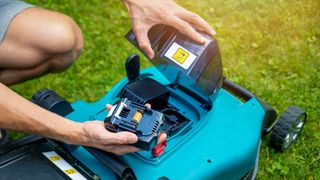Generally speaking, the best electric lawn mowers (opens in new tab) can last up to 10 years if they’re looked after well and stored correctly. However, when it comes to the batteries of the grass cutting machine, it can vary between each brand. Another factor that can affect the lifespan is the type of battery your mower is powered with. Different electric lawn mowers are powered with different batteries – this could be lead-acid batteries or lithium-ion batteries. To help you figure out how long each of these batteries last, how often you should replace your lawn mower battery and how much you can expect to pay, we spoke to expert Lucy Fernando who runs a Fantastic Services (opens in new tab) franchise with her partner Julian.
How long do lawnmower batteries last?
When it comes to a lawn mower’s battery life, each brand is different. Lucy says, “Lithium-ion batteries have a longer lifespan of three to five years (sometimes longer, if properly maintained), while lead-acid batteries last about three years.” According to Lucy, another factor that will negatively impact your battery’s lifespan is the cold weather, which will “cause more internal resistance and lower the battery’s capacity”. The result? “This will lead to more frequent charging,” Lucy says. “Which will surely wear it out prematurely.” Lithium-ion batteries are safest and have a longer lifespan due to more charge/discharge cycles. However, as Lucy tells us, they tend to cost more. Meanwhile, lead-acid batteries are cheaper and tend to work better in colder climates. However, their main drawback is that they last less than lithium-ion ones (around three years) and have fewer charge/discharge cycles (usually around 200-300 cycles).
How often should you replace your lawn mower battery?
So, as we’ve seen, many factors affect the battery life. This includes the climate, terrain, frequency of use, proper maintenance and storage. But, how often should you replace your lawn mower battery? “Generally speaking, lithium-ion batteries are usually replaced around the four-year mark, and lead-acid in their second or third year,” Lucy says. “Some people like to replace them earlier, as if improperly maintained they begin to wear out sooner and hold a smaller charge. If your mower doesn’t start, you should also check for interlock and resistance problems instead of assuming it’s the battery.”
How pricey are lawn mower batteries to replace?
Unfortunately, the battery is the most expensive part of the lawnmower, which, as Lucy says, is all the more reason to properly take care of it to prolong its lifetime. “Lead-acid batteries are cheaper than lithium-ion ones, but they tend to be much heavier and have issues with capacity decrease when being discharged with strong currents. Plus, they don’t support a large number of charging/discharging cycles. Depending on the model and quality, they usually cost anywhere between $19-73,” Lucy explains. “Lithium-ion batteries last longer and have about 500 cycles in their lifetime, sometimes even more if properly maintained. They typically start from $75 dollars and depending on the perks can reach up to $300-400 a piece.”
Tips for prolonging your lawn mower battery
If you’re wondering how to keep your lawn mower cutting around the clock, look this way. As stated by Lucy, there’s a few tips to keep in mind to help prolong the life of your lawn mower’s battery. 1: Upon first use, charge your battery fully The first charging process is critical. “That’s why you should always charge your battery completely before using the lawnmower,” Lucy says. 2: Don’t charge it at every opportunity Every battery has a limited number of charging cycles. “So make sure you don’t charge it at every opportunity,” Lucy says. “Lithium-ion batteries should be charged when they are at 10-20% charge, and lead-acid must never be discharged below 50%, or you might risk irreparable damage.” 3: Store your lawn mower and its battery correctly Lucy says: “Extensive research has shown that they are best stored for the winter at a 40-50% charge. Keep in mind that every month a battery is likely to discharge 3-4% of its capacity. They should be stored in a cool, but not cold environment. Extreme heat is also detrimental. Ideally, they should be removed from the mower (if possible) and stored at temperatures of 5°C to 10°C.” Discover more guides for the garden… Best gas lawn mower (opens in new tab) Best riding lawn mower (opens in new tab) Best robot lawn mower (opens in new tab) Best chainsaw (opens in new tab) Best pressure washer (opens in new tab)






